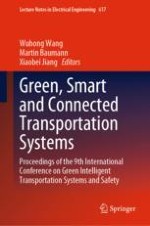2020 | OriginalPaper | Chapter
Passenger Flow Prediction for Urban Rail Transit Stations Considering Weather Conditions
Authors : Kangkang He, Gang Ren, Shuichao Zhang
Published in: Green, Smart and Connected Transportation Systems
Publisher: Springer Singapore
Activate our intelligent search to find suitable subject content or patents.
Select sections of text to find matching patents with Artificial Intelligence. powered by
Select sections of text to find additional relevant content using AI-assisted search. powered by
